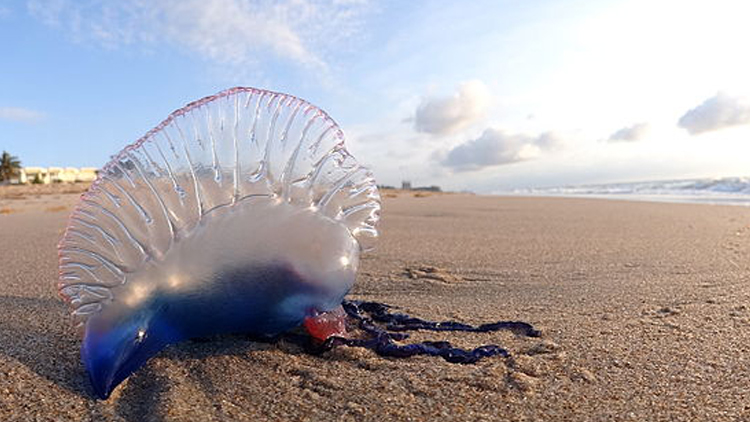Multiple rare sightings of the Portuguese Man-O-War, a jellyfish-like creature with a highly toxic sting, were reported Tuesday on Fire Island—including two cases in which children were stung, officials said.
Suffolk County police said Marine Bureau officers responded to a report of a 4-year-old child stung by one of the poisonous sea creatures known as “Floating Terror” on the beach in Davis Park at 12:17 p.m. and then a 7-year-old child was stung by another near Oak Street in Kismet at 3:08 p.m. Fire Island National Seashore (FINS) rangers also confirmed public reports of Portuguese Man-O-War sightings in Cherry Grove and Fire Island Pines, officials said.
“Hopefully it was an isolated incident,” Tracey Krut, executive assistant to Islip Town Supervisor Angie Carpenter, told the Press.
The 7-year-old child was on shore at the time, not swimming, when he came in contact with the man-o-war, Krut said. Islip town lifeguards aided the boy along with Kismet Fire Department first responders who helped Suffolk police take the child to Southside Hospital in Bay Shore for treatment. He is expected to make a full recovery, Krut said.
Lifeguards put up purple flags indicating dangerous marine wildlife was found in the area and will search the shores to keep swimmers safe, Krut added.
RELATED STORY: 6 Hazards to Beware of at Long Island Beaches This Summer
“Portuguese Man-O-War can cause a painful sting and visitors should maintain a safe distance,” warned Elizabeth Rogers, Science Communications Park Ranger and spokeswoman for FINS. She added: “This is not a common occurrence on Fire Island.”
Portuguese Man-O-War sightings in local waters are unusual since they are usually found in warmer waters in the Caribbean, Pacific and Indian oceans.
WNBC-TV first reported the local sighting while reporting on additional incidents in New Jersey. There have also been sightings at Delaware beaches this summer.
The last reports of Portuguese Man-O-War washing ashore on Long Island was two years ago in the Hamptons.
The creatures are technically a floating colony of organisms that form a pink or purple gas-filled pouch that sails on the surface of the water with numerous tentacles that can grow up to 30-feet or longer, according to the National Oceanic and Atmospheric Administration (NOAA).
Aside from an intense, painful sting, contact with its tentacles can also result in welting and blistering, NOAA said. In rare cases, its sting has reportedly proven deadly.
Police said they also received a second unconfirmed report of a Portuguese Man-O-War in Kismet on Tuesday, but there were no reported injuries stemming from that call.
“Portuguese Man-O’-War are easy to see,” said Grace Kelly-McGovern, spokeswoman for the Suffolk County Department of Health Services. “We advise beach goers to stay away from them when they see them. If you are stung, rinse the affected area with salt water, apply vinegar or a baking soda paste and take a pain killer if needed. If you experience a severe reaction to the sting, seek immediate medical attention.”


























